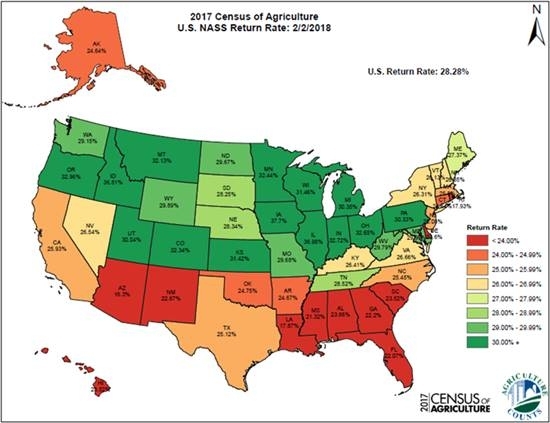Census of Agriculture response deadline one week away
WASHINGTON, Jan. 29, 2018 –The U.S. Department of Agriculture's (USDA) National Agricultural Statistics Service (NASS) reminds our nation's farmers and ranchers that the deadline for the 2017 Census of Agriculture is one week away. Producers should respond online at www.agcounts.usda.gov or by mail by February 5. The online questionnaire offers new timesaving features.
The Census of Agriculture is the only NASS questionnaire mailed to every producer across the country and is conducted just once every five years. The Census provides a complete account of the industry, its changes, and emerging trends. Census data are widely used, often relied on when developing the Farm Bill and other farm policy, and when making decisions about disaster relief, community planning, technology development, and more.
“We are asking producers to help show our nation the value and importance of American agriculture,” said U.S. Secretary of Agriculture Sonny Perdue. “We need to hear from all of our farmers and ranchers, no matter how big or how small their part of agriculture. The Census is their voice, their future, their opportunity. Please respond now.”
Everyone who received the 2017 Census of Agriculture questionnaire is to return it, even if they are not currently farming. The first few qualifying questions on the form will determine whether completing the entire questionnaire is necessary. After the February 5 deadline, NASS will begin following-up with additional mailings, e-mails, phone calls, and personal appointments. To avoid these additional contacts, farmers and ranchers are asked to complete their Census as soon as possible.
“It is important that every producer respond to the Census of Agriculture so that they are represented and reflected in the data,” said NASS Administrator Hubert Hamer. “These statistics can directly impact producers for years. Without their input, our hardworking farmers and ranchers risk being underserved.”
The Census is the only source of uniform, comprehensive, and impartial agriculture data for every state and county in the nation. Producers are required by law to respond; NASS is required by the same federal law to keep all information confidential, use the data only for statistical purposes, and only publish in aggregate form to prevent disclosing the identity of any individual producer or farm operation.
For more information about the 2017 Census of Agriculture, visit www.agcensus.usda.gov or call (800) 727-9540.
About The Census
- What is the Census of Agriculture?
The Census of Agriculture is a complete count of U.S. farms and ranches and the people who operate them. Even small plots of land - whether rural or urban - growing fruit, vegetables or some food animals count if $1,000 or more of such products were raised and sold, or normally would have been sold, during the Census year.
The Census of Agriculture, taken only once every five years, looks at land use and ownership, operator characteristics, production practices, income and expenditures. For America's farmers and ranchers, the Census of Agriculture is their voice, their future, and their opportunity.
Frequently asked questions about the 2017 Census.
- Why is the Census of Agriculture important?
The Census of Agriculture provides the only source of uniform, comprehensive and impartial agricultural data for every county in the nation. Through the Census of Agriculture, producers can show the nation the value and importance of agriculture, and they can help influence the decisions that will shape the future of American agriculture for years to come. By responding to the Census of Agriculture, producers are helping themselves, their communities, and all of U.S. agriculture.
- Who uses Census of Agriculture data?
Census of Agriculture data are used by all those who serve farmers and rural communities — federal, state and local governments, agribusinesses, trade associations and many others.
- Farmers and ranchers can use Census of Agriculture data to help make informed decisions about the future of their own operations.
- Companies and cooperatives use the facts and figures to determine the locations of facilities that will serve agricultural producers.
- Community planners and local governments use the information to target needed programs and services to rural residents.
- Legislators use the numbers from the Census when shaping farm policies and programs.
- To see some specific examples of how the data are used, see our Your Census. Your Story. If you use census data, please add your example to the page.
- How can I participate in the 2017 Census of Agriculture?
- Make Sure Your Farm or Ranch Counts. Sign up for the Census.
- As a Census Partner, you can help everyone learn and understand the latest Census results and how the information can benefit them, their community, and their industry. Click here to access the Partner Tools.
- Where can I access information about previous Censuses?
Attached Images:
